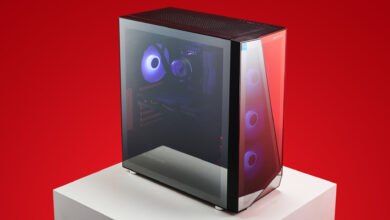This has been quite a year for gaming laptops. AMD launched its Ryzen 6000-series mobile CPUs, Intel unleashed Alder Lake for the same market, and Nvidia has added to the existing mobile GPU line-up with the RTX 3080 Ti and RTX 3070 Ti. Given things were already pretty healthy in the laptop space, these latest releases have given laptop manufacturers plenty of choices when it comes to piecing together powerful machines.
For the new Aorus 17 XE4, Gigabyte has decided to put Intel’s Alder Lake to work alongside the more sensible of Nvidia’s new offerings. Specifically, you’re looking at an Intel Core i7 12700H running alongside an Nvidia GeForce RTX 3070 Ti. This is a solid pairing that is capable of producing strong figures in both gaming and more serious applications without totally breaking the bank.
The Intel Core i7 12700H isn’t the top-end chip, but it still brings plenty of cores and a high clock speed to make sure that you’re not left wanting. You get a total of 14 cores here, made up of six Performance cores and eight Efficient cores, to give Windows a total of 20 threads to play around with. Those Performance cores can Turbo up to 4.7GHz, while the Efficient cores max out at 3.5GHz. Speedy.
As for the GPU, the RTX 3070 Ti is an impressive slice of modern silicon that can hit silly numbers at this screen’s native 1080p. At 130W, the RTX 3070 Ti inside the Aorus 17 is more powerful than some RTX 3080s we’ve seen from other manufacturers. It really isn’t just about how fast a GPU is anymore, or how many CUDA cores a GPU has, but how much power the GPU can set aside for its own ends. And 130W is a lot more than many laptops can manage—particularly those thin and light machines that look great, but don’t have the cooling to handle such beefy GPUs.
(Image credit: Future)
CPU: Intel Core i7 12700H
GPU: Nvidia GeForce RTX 3070 Ti (130W)
RAM: 16GB (2x 8GB) DDR4-3200
Display: 17.3-inch
Native res: 1920 x 1080
Refresh rate: 360Hz
Storage: 1TB PCIe 4.0 SSD
I/O: 1x gigabit LAN, 1x HDMI 2.1, 1x Headphone/Mic, 1x Mini DisplayPort 1.4, 1x Thunderbolt 4, 2x USB 3.2 Gen1 Type-A
Dimensions: 398 x 254 x 27mm
Weight: 2.7kg
Price: $2,099 | £1,999
The Aorus 17 does a clever impression of a thin and light laptop. The base cuts away from the thickest part of the chassis on the front edge, so that when you’re actually using it, you can easily be fooled into thinking it’s thinner than it really is. Importantly, this means that it is actually thick enough to house a proper cooling system, one that stands a good chance of keeping the aforementioned CPU and GPU cool.
There’s one annoying misstep on the styling front though: the power button. While this is clearly still a gaming machine, by dint of its thickness, it’s a mostly subdued affair with a clean aesthetic. Particularly so if you ease back on the keyboard’s default RGB light show. But that squishy-looking power button wouldn’t look out of place on a child’s toy. Not something you expect to see on a machine rolling in for $2,000.
The rest of the specification is pretty much what you’d expect, with a speedy 1TB NVMe SSD keeping things moving and 16GB of RAM as standard, although Gigabyte has stuck with DDR4 here and not gone with DDR5. A prudent choice given the value/performance proposition of the newer memory standard, although you can’t help but feel that you’re missing out on the newest thing when looking down the spec list, despite not really being able to tell the difference in practice.
(Image credit: Future)
Before moving on to the all-important performance, it’s worth highlighting the keyboard, which is roomy and responsive. There’s even a full numpad, although there’s no delineation between it and the main keyboard, which can feel weird at times. Still, the keyboard as a whole is comfortable to type on and more than capable of handling your gaming needs. The touchpad is generous too, although it isn’t particularly useful when it comes to gaming. As ever, you really want a decent mouse if you’re serious about gaming on the go.
The final important piece of the portable gaming puzzle is the 360Hz 1080p display, and here you’re looking at a relatively massive 17.3-inch panel squeezed into what Gigabyte suggests is a 15-inch chassis. While physics would take issue with that suggestion, it does have a good screen-to-laptop ratio with thin bezels on the top and sides, and the laptop itself is ever so slightly smaller than some traditional 17-inch gaming laptops. I mean it’s big, don’t get me wrong, but it could be even bigger.
(Image credit: Future)
(Image credit: Future)
(Image credit: Future)
(Image credit: Future)
(Image credit: Future)
(Image credit: Future)
(Image credit: Future)
(Image credit: Future)
(Image credit: Future)
This brings us to the performance. And it’s here where the Gigabyte Aorus 17 XE4 shines brightest. It may not be the fastest machine we’ve ever seen, it’s not the thinnest nor quietest either, but for the money, it takes some serious beating for balancing all these things and focusing on what really counts for most gamers: performance. Here this machine is pretty much at the top of its game, and capable of outperforming more expensive laptops.
That 130W Nvidia GeForce RTX 3070 Ti is the key ingredient here, but the fact that Gigabyte has paired it with a Core i7 chip as opposed to the far-more expensive Core i9 pays dividends in the value-for-money stakes. Either way, you’re looking at smooth frame rates in pretty much any game you throw at it. Metro Exodus manages 76fps with RTX pretties on, Horizon Zero Dawn 117fps, and F1 2020 tops out at a silky 180fps.
You could argue that an RTX 3070 Ti is overkill for a 1080p display, but that would be forgetting that 360Hz refresh rate. This machine, more than most, actually stands a good chance of getting a frame rate close to that refresh rate. If you enjoy a good game of Apex Legends, Valorant, or CS:GO then you’re going to hit frankly ridiculous frame rates (300fps in Apex is fairly easy to achieve), and know that your losses are due to your reactions, not this laptop’s inability to keep up.
(Image credit: Future)
(Image credit: Future)
(Image credit: Future)
(Image credit: Future)
(Image credit: Future)
The one downside is that pushing this laptop hard will punish your ears. The Aorus 17 XE4 can get annoyingly loud in use. To the point that you’ll find yourself either reaching for a headset when gaming, or pushing the volume up high to try and drown out the “Windforce Infinity Cooling System” at full bore. At least you have the option of playing in Silence Mode, and there’s still plenty of power on offer if you favor the quiet life, at least there is if you tackle your game’s setting screen.
(Image credit: Future)
Best gaming PC: The top pre-built machines from the pros
Best gaming laptop: Perfect notebooks for mobile gaming
Obviously, £1,999 ($2,099) is still a large bag of cash to drop on any laptop, even one that is as gamey as this. It’s a bit galling that so much money doesn’t buy you top-of-the-range components anymore, although just throwing all the top kit into a laptop rarely actually pays off, with thermal limits often keeping such dream machines in check. Essentially paying much more than this and you’re in diminishing returns territory.
The real question you need to ask yourself, is do you want your gaming to be a bit more portable? I’ll admit to preferring something more modest myself, those 13- and 14-inch laptops are often far more versatile, even if they don’t pack the same gaming punch that this can muster. Still, if you’re looking for a serious desktop replacement, then there’s plenty to love here. Particularly when it comes to actual gaming. It’s just a shame it’s so loud about it.






